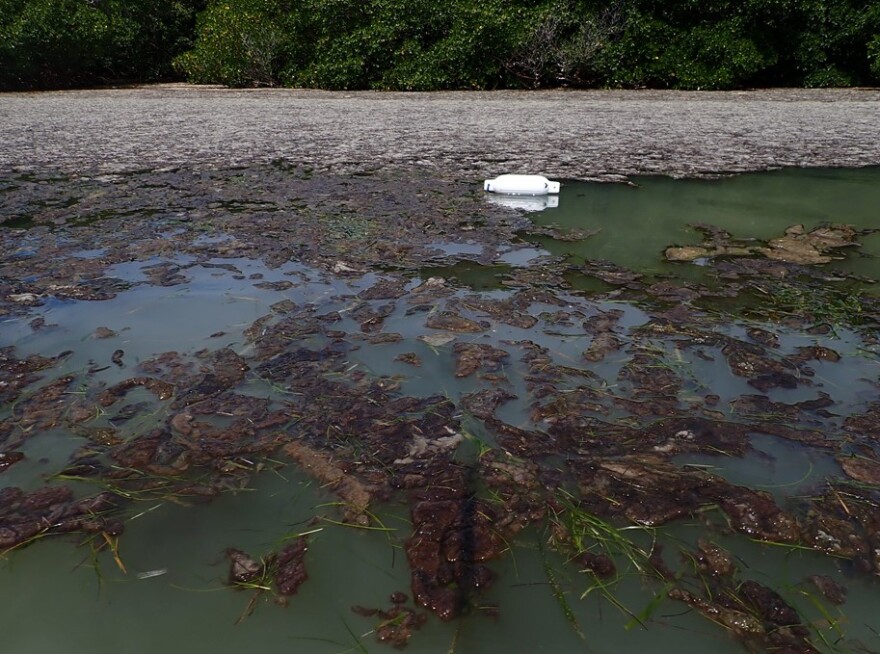Tampa Bay is experiencing multiple algae blooms. Toxic red tide has made its way north to the Pinellas County coast from Collier County and around Port Manatee. But there are also Lyngbya-like cyanobacteria blooms, which are stringy green mats floating in Joe Bay, Anna Maria Sound, and just north of Port Manatee — near where more than 200 million gallons of nutrient-rich wastewater was dumped from the Piney Point phosphate plant back in March.
Scientists think nutrients, such as nitrogen, from that spill are feeding both types of algae blooms, although results are pending to scientifically confirm this.

When water quality tests stopped measuring nutrients in the water, people began assuming they had just dissipated and were gone. But that’s not the case, said Maya Burke, with the Tampa Bay Estuary Program.
“Helping people understand this issue of nutrient cycling and how the nitrogen gets transferred from organism to organism and kind of stays within the system is something that I think is really important for the public to understand,” she said.
The Tampa Bay Estuary Program is part of a large effort to monitor the bay's water quality, including multiple government entities, private sector partners, and universities.
WUSF's Jessica Meszaros spoke to Burke about the current state of nutrients and algae in Tampa Bay:
Based on the status reports, it looks like concentrations of the red tide organism Karenia brevis appear to be higher around Port Manatee. Could that be caused by lingering nutrients from the Piney Point discharges?
That's what we think is going on for certain. I mean, I don't think it's a coincidence that you're seeing these algae blooms in the vicinity of the place where we discharged more than 200 tons of nitrogen over the period of 10 days.
That's not to say it's the only thing that's going on, though. I mean, we know Karenia brevis was in the Gulf of Mexico beforehand, and it had been systematically making its way northward, so it's about sort of how that species was interacting with the nutrients. Once it did get in here through these larger oceanographic phenomena, like currents, wind, tides, those sorts of things.
And same with the Lyngbya-like blooms that we're seeing. Those were documented in Manatee County a month before the spill, so they were there already. But are they worse now? Maybe. that's why we're monitoring.
Red tide seemed to flow into the mouth of Tampa Bay along the same lines as the Piney Point discharges flowed out. Could that just be a coincidence, or is there a connection?
That makes sense that that's where we're seeing things because we wouldn't necessarily otherwise be measuring up in the bay like that until you started to get things like a fish kill.
Some of the spatial distribution of the monitoring is an artifact of the monitoring that we're doing for Piney Point. So, there is that kind of thing that is perhaps coincidental, but we don't always see Karenia make its way up into the bay. Sometimes it stays more along the barrier islands in the intercoastal waterways, and sometimes it makes its way up there.
Like I said, there's a few things that are going on: the fact that the bay was really salty because it was so dry made it more hospitable. And so, Karenia is more likely to come inward in those kinds of instances. But once we saw it come inward, it didn't come in at medium concentrations, right? It came in, and we were getting those low to very low hits. Once it's interacting with the nutrients that are in that vicinity of the spill, that's when we started to see the intensification towards those medium levels, which is a bloom threshold. And that's when you start to get things like the fish kills that we're reporting now.
What do you think the rest of the summer is going to look like in Tampa Bay? Is it possible to know?
I don't know. You know, scientists are never fun, we don't like to hazard guesses like that. We're kind of like, hoping for a little rain to help freshen the bay up, but this is the time that we tend to see the highest nutrient loads and the highest chlorophyll levels in the bay.
So, too much rain is also not good, because we've already got a significant nutrient load in the bay as a result of this spill, and so we don't want to make that any worse. I'll also just put a plug out there that, you know, that's part of the reason in many parts of our watershed, we have a summertime fertilizer ban.
We asked folks not to apply nitrogen fertilizer to their yards in the summer rainy season because rather than feeding your lawn, they're likely to run off and hit the bay. And then they feed algae blooms in the bay.
A little rain to freshen things up, but not too much to get too much nutrients in the bay. I think everybody's a little bit on pins and needles because this is pretty early in the season to see the red tide bloom within the bay. And so, we don't really want to see it get worse. So those are some of the things that we worry about, but we can't control the weather, we can only control sort of what we do as a community in terms of the nutrient inputs that we put there. And so, for us, that's always been where it's at. What are the things that we can control? We can control our nutrient pollution. And we know that this year the bay took a big hit, and so we need everybody to do their part to make up for what they can.





